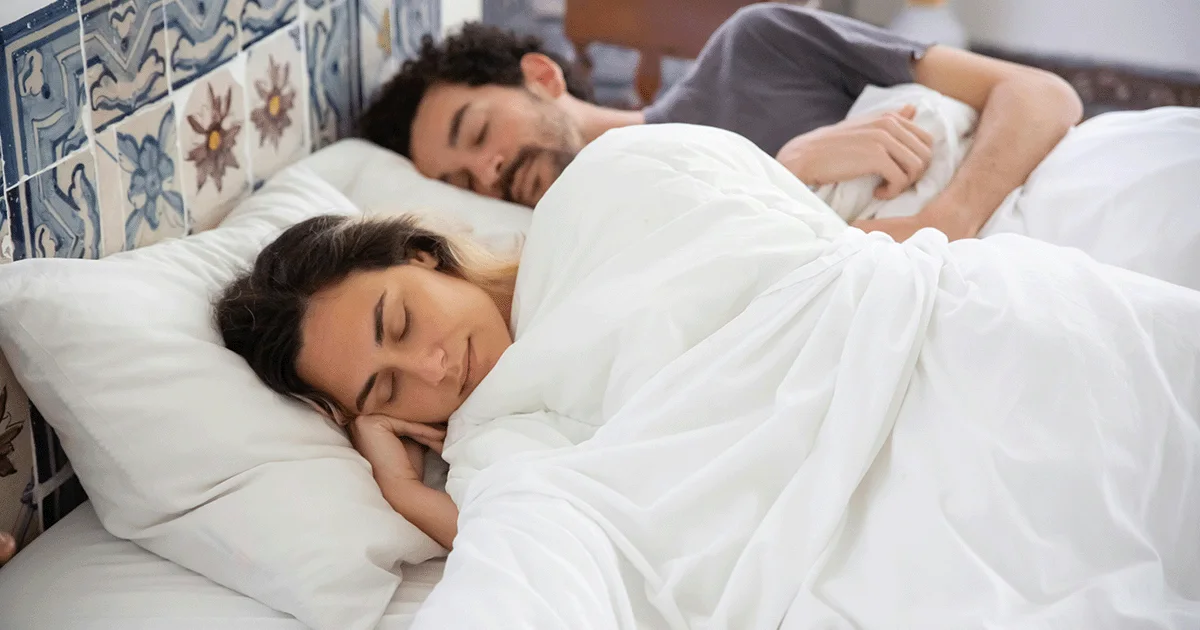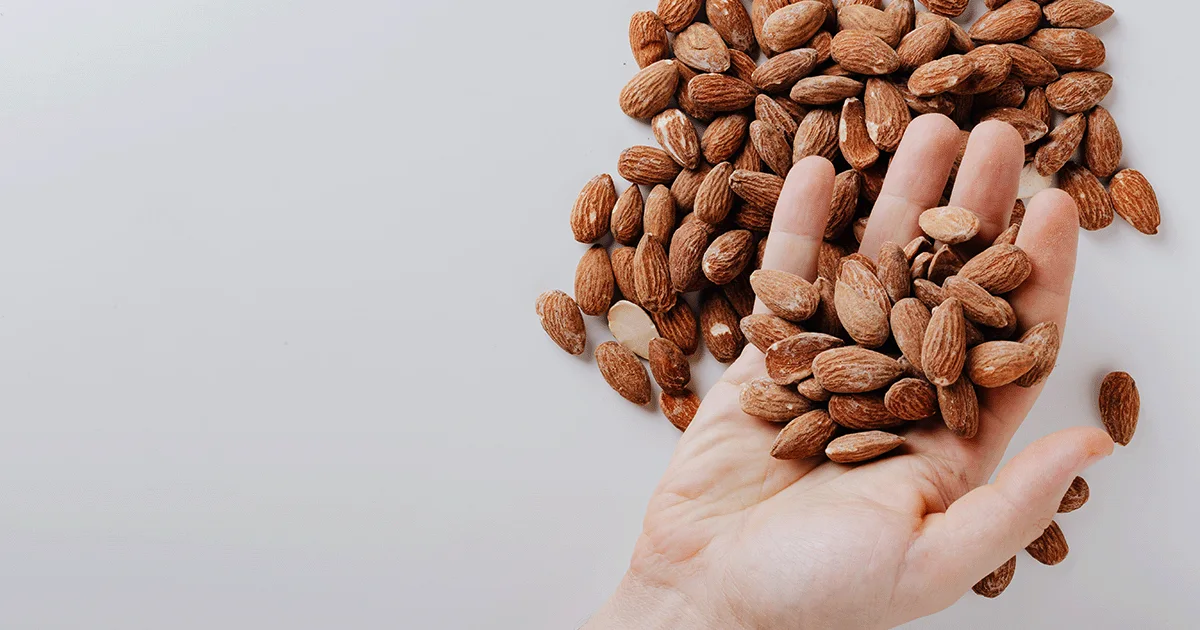Here's what we'll cover
Here's what we'll cover
Having an orgasm or “climaxing” is often used as the measure of good sex—at least, that’s what movies, TV shows, and porn lead us to believe. In reality, many people either don’t have orgasms or have a hard time achieving them.
According to some studies, only about 25% of women always have an orgasm during vaginal sex. As for men, about 8% have delayed or absent orgasms (Wallen, 2011; Hollander, 2016). Another study that looked at over 50k adults in the U.S. found that 95% of heterosexual men reported they usually or always orgasmed during sex, compared to only 65% of heterosexual women (Frederick, 2018).
If you’re finding that you cannot have an orgasm and it’s negatively affecting you or your partner, there are steps to take to overcome the issue.
What is anorgasmia?
Anorgasmia is the persistent absence of an orgasm even if you’re sexually stimulated. Experts use the term “anorgasmia” when the situation has reached a point where it is causing distress, which typically happens because the issue is persistent and continues over many months or years.
Sorting out what causes anorgasmia is often not so simple, so it’s important to look at everything going on in your life to determine why this could be happening (Jenkins, 2015).
Physical and psychological problems can both cause anorgasmia. For example, if you’re having problems in your relationship, that can lead to the inability to have an orgasm. It can also be a lifelong experience or a recent change. Some find they can only have an orgasm in certain situations, which may affect their sex lives negatively.
Symptoms of anorgasmia in women
If you’re a woman experiencing anorgasmia, the biggest symptom is that you’re consistently having difficulty reaching orgasm, despite trying. You may feel desire and arousal, but the orgasm either never happens, is consistently delayed, or is unsatisfying (Faubion, 2015).
It may help to know that most women do not always have orgasms during vaginal sex. It also takes, on average, 10-15 minutes to reach orgasm, so if this sounds like you, know that these things are normal, and you’re probably not dealing with anorgasmia (Bhat, 2020).
Additionally, if you have other things on your mind, aren’t happy with your partner, or are stressed, these thoughts and emotions can be a hurdle to reaching an orgasm. And that’s normal, too. However, if you feel personal distress over having delayed orgasms, no orgasms, or unsatisfying orgasms, then it may be time to seek solutions.
Symptoms of anorgasmia in men
Anorgasmia in men describes the inability to reach orgasm during sexual stimulation—including masturbation—and it causes personal distress related to sex.
About 8% of men have delayed or absent orgasm (Hollander, 2016). Male anorgasmia should not be confused with erectile dysfunction or low libido (lack of sexual desire), even though these conditions can exist together. Delayed orgasms or no orgasms can also be frustrating or cause anxiety, leading to other sexual problems like erectile dysfunction (ED) and loss of sex drive.
Types of anorgasmia
Anorgasmia is generally divided into three categories. These can include many experiences and causes (Jenkins, 2015):
Primary anorgasmia (lifelong): Some women have never had an orgasm. Sometimes cultural norms affect this or steer women away from exploring their bodies. Men can also experience this. Primary anorgasmia begins from your first sexual experience and lasts throughout life.
Secondary anorgasmia (acquired): Many women and men report having a satisfying sex life with orgasms, only to find their orgasms change over time. They may become less frequent, take longer to achieve, or stop altogether. Causes can range from life stressors to medical conditions.
Situational anorgasmia: This type of anorgasmia occurs when you have difficulty reaching orgasm in certain situations. This could range from your location, to the partner you’re with to, the type of stimulation you’re receiving. Some men, for example, may find they can only reach orgasm through masturbation.
Causes of anorgasmia in women
There are many causes of anorgasmia, and they fall into two categories: physical causes or psychological and social causes.
Physical causes of anorgasmia in women include (NLM, 2020):
Medications: Antidepressants (Prozac [generic name fluoxetine], Paxil [generic name paroxetine], Zoloft [generic name sertraline]), for example, can make it harder to have an orgasm.
Hormonal disorders
Hormonal changes, such as menopause, childbirth, breastfeeding
Medical conditions that can affect health and sexual interest
Chronic pelvic pain, such as from endometriosis
Nerve damage
Pelvic muscle spasms
Vaginal dryness (can make sex uncomfortable and limit orgasm)
Sometimes, psychological or social causes are to blame. These include (NLM, 2020):
Stress, fatigue, or depression
Conflict with a partner
Limited knowledge about sex
Not asking for the type of foreplay that works best for you
Boredom with sex or a relationship
Negative feelings about sex
A history of sexual abuse
Causes of anorgasmia in men
While it can occur in younger men, as men age, the risk of anorgasmia increases, and there are many causes. And as with women, anorgasmia is either caused by something physical, psychological, or social (Rowland, 2010).
Physical causes of anorgasmia in men include (Rowland, 2010):
Endocrine/hormonal problem (testosterone deficiency, hypothyroidism, hyperprolactinemia) (Alwaal, 2015)
High blood pressure/cardiac/hypertension
Medications (some antidepressants and antipsychotic drugs)
Alcohol
Drugs (opioids, heroin)
Multiple sclerosis
Parkinson’s disease
Neuropathy
Prostate cancer surgery (prostatectomy)
Congenital conditions
And the psychological or social factors that may cause anorgasmia in men are (Jenkins, 2015) :
Depression
Sexual trauma
Other psychological issues
Anorgasmia treatment
It’s important that your healthcare provider gets your full medical history and understands any potential social or relationship factors that may be contributing to your anorgasmia.
They will likely ask you about your sexual history, surgical history, medication use, and if you have a partner, whether you are having any problems in your relationship. They will also conduct a general physical exam to look for any physical causes of your anorgasmia. They may run some tests like blood work to check your hormone levels and see how various parts of your body are functioning (Jenkins, 2015).
Depending on your discussion and exam results, your healthcare provider may suggest a specialist such as a urologist, gynecologist, psychologist, a couples counselor, or a sex therapist. While treatments for anorgasmia vary depending on the causes, sometimes it can be helpful to combine treatment and lifestyle approaches.
Anorgasmia treatments for women
If you’re a woman and your anorgasmia is due to a medical condition, your treatments may include (Krakowsky, 2018; Faubion, 2015):
Treating underlying medical conditions like diabetes
Estrogen therapy (postmenopausal women)
Testosterone therapy (off label) for some women with low testosterone
Switching medications: The antidepressant bupropion (brand name Wellbutrin), for example, has a lower incidence of sexual side effects and may be able to replace SSRIs that are leading to anorgasmia (Montejo, 2019)
Trying different types of sexual stimulation (positions, devices such as vibrators, clitoral vacuum) (Prause, 2016)
And, if your healthcare provider determines that psychological or social factors are causing your anorgasmia, they may recommend (Marchand, 2020):
Assessing and reducing stress levels
Psychotherapy to address any personal or interpersonal issues and psychological factors that may be limiting the ability to have an orgasm
Couples counseling
Couples mindfulness exercises to enhance appreciation for sex and embrace the present while letting go of distracting thoughts (Leavitt, 2019)
Sex therapy to discuss ways of viewing sex differently (a sex therapist is a trained professional who has a range of techniques and approaches that may create a change in your sex life, which may improve the ability to reach orgasm)
Anorgasmia treatments for men
Men can have some of the same personal life stressors that affect orgasms as women do. Sorting through relationships or other personal issues may provide answers. And, as is the case with women, it’s important to rule out medical conditions.
If a medical condition is the cause, treatments include (Jenkins, 2015):
Addressing underlying medical conditions like high blood pressure
Dostinex (cabergoline): a dopamine-promoting drug may be able to restore the ability to reach orgasm in some men (Hollander, 2016)
Switching medications: As with women, the antidepressant bupropion has a lower incidence of sexual side effects in men and may be able to replace SSRIs that can affect orgasms (Montejo, 2019)
Prostate massage (hitting the male ‘G-spot’)
For men with anorgasmia brought on by psychological or social factors, many of the same approaches that benefit women are effective. They include stress reduction, psychotherapy, sexual therapy, couples counseling, and mindfulness exercises (Jenkins, 2015).
When to see a healthcare provider
If you’ve been experiencing problems with orgasms and it’s causing distress, talking to your primary healthcare provider is a good start. Expect a review of your medical history, an evaluation of all medications you take or have taken in the past, and a physical exam.
Depending on your discussion and exam results, your healthcare provider may suggest a specialist such as a urologist, gynecologist, psychologist, a couples counselor, or a sexual therapist. It often helps to combine treatment and lifestyle approaches and find the one that works for you.
If your inability to have an orgasm has left you feeling distressed or embarrassed, know that you are not alone. There are treatments available that can help you have a more enjoyable and fulfilling sex life.
DISCLAIMER
If you have any medical questions or concerns, please talk to your healthcare provider. The articles on Health Guide are underpinned by peer-reviewed research and information drawn from medical societies and governmental agencies. However, they are not a substitute for professional medical advice, diagnosis, or treatment.
Alwaal, A., Breyer, B. N., & Lue, T. F. (2015). Normal male sexual function: Emphasis on orgasm and Ejaculation. Fertility and Sterility , 104 (5), 1051–1060. doi: 10.1016/j.fertnstert.2015.08.033. Retrieved from https://www.ncbi.nlm.nih.gov/pmc/articles/PMC4896089/
Bhat, G. S. & Shastry, A. (2020). Time to orgasm in women in a monogamous stable heterosexual relationship. The Journal of Sexual Medicine , 17 (4), 749–760. doi: 10.1016/j.jsxm.2020.01.005. Retrieved from https://www.jsm.jsexmed.org/article/S1743-6095(20)30030-8/fulltext
Faubion, S. S. & Rullo, J. E. (2015). Sexual dysfunction in women: A practical approach. American Family Physician 92 (4), 281-288. Retrieved from https://www.aafp.org/afp/2015/0815/p281.html
Frederick, D. A., John, H., Garcia, J. R., & Lloyd, E. A. (2018). Differences in Orgasm Frequency Among Gay, Lesbian, Bisexual, and Heterosexual Men and Women in a U.S. National Sample. Archives of Sexual Behavior, 47 (1), 273–288. doi: 10.1007/s10508-017-0939-z. Retrieved from: https://pubmed.ncbi.nlm.nih.gov/28213723/
Hollander, A. B., Pastuszak, A. W., Hsieh, T. C., Johnson, W. G., Scovell, J. M., Mai, C. K., & Lipshultz, L. I. (2016). Cabergoline in the treatment of male orgasmic disorder—a retrospective pilot analysis. Sexual Medicine , 4 (1). doi: 10.1016/j.esxm.2015.09.001. Retrieved from https://www.smoa.jsexmed.org/article/S2050-1161(16)00007-6/fulltext
Jenkins, L. C. & Mulhall, J. P. (2015). Delayed orgasm and anorgasmia. Fertility and Sterility , 104 (5), 1082–1088. doi: 10.1016/j.fertnstert.2015.09.029. Retrieved from https://www.ncbi.nlm.nih.gov/pmc/articles/PMC4816679/
Krakowsky, Y. & Grober, E. D. (2018). A practical guide to female sexual dysfunction: An evidence-based review for physicians in Canada. Canadian Urological Association Journal , 12 (6), 211–6. doi: 10.5489/cuaj.4907. Retrieved from https://www.ncbi.nlm.nih.gov/pmc/articles/PMC5994984/
Leavitt, C. E., Lefkowitz, E. S., & Waterman, E. A. (2019). The role of sexual mindfulness in sexual wellbeing, Relational Wellbeing, and self-esteem. Journal of Sex & Marital Therapy , 45 (6), 497–509. doi: 10.1080/0092623x.2019.1572680. Retrieved from https://www.ncbi.nlm.nih.gov/pmc/articles/PMC6640099/
Marchand, E. (2021). Psychological and behavioral treatment of female orgasmic disorder. Sexual Medicine Reviews , 9 (2), 194–211. doi: 10.1016/j.sxmr.2020.07.007. Retrieved from https://pubmed.ncbi.nlm.nih.gov/33069622/
Montejo, A. L., Prieto, N., de Alarcón, R., Casado-Espada, N., de la Iglesia, J., & Montejo, L. (2019). Management strategies for antidepressant-related sexual dysfunction: A clinical approach. Journal of Clinical Medicine , 8 (10), 1640. doi: 10.3390/jcm8101640. Retrieved from https://www.ncbi.nlm.nih.gov/pmc/articles/PMC6832699/
National Library of Medicine (NLM). (2020). Orgasmic dysfunction in women . Retrieved Jan. 27, 2022 from https://medlineplus.gov/ency/article/001953.htm
Prause, N., Kuang, L., Lee, P., & Miller, G. (2016). Clitorally stimulated orgasms are associated with better control of sexual desire, and not associated with depression or anxiety, compared with vaginally stimulated orgasms. The Journal of Sexual Medicine , 13 (11), 1676–1685. doi: 10.1016/j.jsxm.2016.08.014. Retrieved from https://pubmed.ncbi.nlm.nih.gov/27667356/
Rowland, D., McMahon, C. G., Abdo, C., Chen, J., Jannini, E., Waldinger, M. D., & Ahn, T. Y. (2010). Disorders of orgasm and ejaculation in men. The Journal of Sexual Medicine , 7 (4), 1668–1686. doi: 10.1111/j.1743-6109.2010.01782.x. Retrieved from https://onlinelibrary.wiley.com/doi/full/10.1111/j.1743-6109.2010.01782.x
Wallen, K. & Lloyd, E. A. (2011). Female sexual arousal: Genital anatomy and orgasm in Intercourse. Hormones and Behavior , 59 (5), 780–792. doi: 10.1016/j.yhbeh.2010.12.004. Retrieved from https://www.ncbi.nlm.nih.gov/pmc/articles/PMC3894744/










